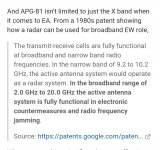Look at how vague the advertisements are and compare it to the EPAWSS.
BAE Systems has 60 years of electronic countermeasures experience. Our digital electronic warfare system (DEWS) is a proven countermeasure dispenser.

www.baesystems.com
DEWS:
Designed to meet current and future threats, DEWS provides accurate and quick 360-degree aircraft protection and
jamming across the frequency band, providing the aircrew with the latest situational awareness.
DEWS integrates its receiver, digital radio-frequency memory jamming, and countermeasures dispenser with the aircraft central computer and radar. DEWS simultaneous jamming and receiving, allows it to operate in the battlefield of tomorrow.
EPAWSS:
EPAWSS is equipped with advanced radio frequency (RF) electronic countermeasures (ECM),
enabling deeper penetration against modern integrated air defense systems and providing rapid response capabilities designed to protect the aircrew.
Very, very vague for the DEWS vs very, very accurate for the EPAWSS. What the DEWS does is pretty much what towed decoys do, basically simultanous jamming and receiving.
Even the datasheet for the DEWS is this...
System capabilities include all-aspect, broadband radar warning; emitter location; multispectral RF/IR countermeasures; and response management.
Multispectral RF/IR countermeasures simply refer to the towed decoys and flares.
The very, very clear EPAWSS datasheet:
Offensive and defensive digital electronic warfare capabilities
Multi-spectral, radio frequency (RF) and infrared (IR) countermeasures (clear separation from off and def EW capabilities)
This is what towed decoys do.
These "little buddies" not only protect the jet, but they can be used creatively to goad the enemy into showing itself and dying as a result.

www.thedrive.com
Since then, little buddies have morphed from decoy target to advanced electronic warfare-enabled extensions of the plane's own self-protection suite. The ALE-55 that is reeled out from the center of the Super Hornet's belly is capable of jamming enemy emitters in an effort to keeping them from locking onto the aircraft, or directly executing electronic attacks on an emitter that has already locked on, or goading a missile into attacking it instead of the aircraft if an attack is already underway.
This is how the F-35 performs electronic attack using the EW suite. It doesn't have dedicated jamming capability from inside its own airframe, except the radar. The towed decoy reels out, performs electronic attack from a very safe distance from the F-35. Which is why the DEWS clearly separates itself from the EPAWSS's "
Offensive and defensive EW" terminology. And unlike the ALE-55, the ALE-70 on the F-35 actually uses the techniques generator from onboard the F-35's EW suite instead of having one inbuilt. So it's a much more advanced capability than what's on the ALE-55.







